
Washes Route, Downhill
Hiking Around Las Vegas , Lake Mead National Recreation Area

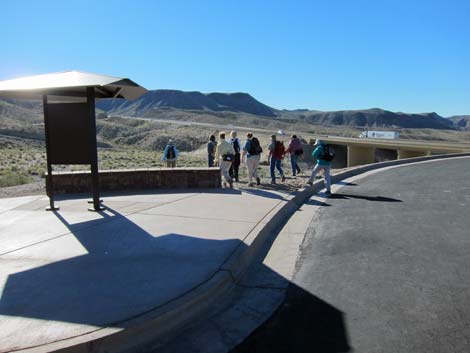 Hikers departing the trailhead (view SW) |
Due to extreme temperatures, this area is closed during summer (usually May 15 to September 30). Link to details (PDF). Overview In addition to the Regular Route (White Rock Canyon) to Arizona Hot Spring, two other good routes lead down Hot Spring Canyon to the hot spring. The first, the Washes Route, is longer (2.8 miles) and easier, but requires downclimbing several pour-overs, including one that is 30-ft high and 4th-class. The second, the Mountains Route, is shorter (2.2 miles) and steeper, but avoids the climbing. Either way, this volcanic area is geologically interesting, and both routes lead to thigh-deep hot pools in the bottom of a deep, narrow slot canyon near the Colorado River. Using a tall ladder beyond the hot springs, hikers can continue to the Colorado River and restrooms. Arizona Hot Springs is a place to sit, relax in the warm water, and meet interesting people. Link to map or elevation profile. |
 Departing the trailhead (view SW) |
Hiking down the steep Mountains Route or hiking down the White Rock Canyon Route and hiking back up the Wash Route makes a nice loop. There are several nice places to camp down by the river where toilet facilities are available. Arizona Hot Spring is sometimes called Ringbolt Hot Springs, a reference to Ringbolt Rapids that now lie submerged in the Colorado River, just upstream from the mouth of Hot Spring Canyon. There is no longer any evidence of a rapid. Watch Out Because of extreme summer temperatures, more and more hikers were being rescued from this area in the early 2010s, and some even died. The extreme temperatures also put the lives of rescue personnel at risk, and therefore, the National Park Service closes this area during summer. |
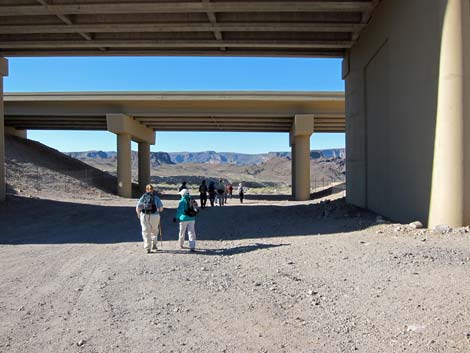 Hikers passing under Highway 93 (view SE) |
In 2023, water quality monitoring at Arizona Hot Springs revealed unsafe levels of bacterial contamination, including fecal coliform, enterococci, and E. coli. The NPS removed sandbags to allow the water to flow freely, and contamination levels fell quickly. If bacterial contamination rises again, the NPS will close Arizona Hot Springs until water quality returns to safer levels. Other than the standard warnings about hiking in the desert, ...the washes route is a fairly easy hike punctuated by three exciting pour-overs to downclimb. Most people probably would prefer a rope for the first, 30-ft downclimb. At the hot springs, be careful walking on wet rocks after you've picked up sand on the bottom of your shoes. |
 Trailhead signs (view SW) |
Because of past law suits, the Park Service posts signs warning about Naegleria fowleri, a bacterium present in warm waters like home hot tubs and hot springs. While this bacterium may be present here, it is not the extreme hazard it is made out to be by hysterical parties. It is, however, a good idea to keep your nose dry while in the hot pools. While hiking, please respect the land and the other people out there, and try to Leave No Trace of your passage. Also, this is a moderately long hike in a remote area, so be sure to bring the 10 Essentials. Be sure that you are physically fit and that you choose routes of the appropriate difficulty for your skills and endurance. In recent years, water at the hot spring has become contaminated with Escherichia coli (E. coli), human fecal bacteria, because people are walking upstream from the hot pools and pooping. Don't do this; it is gross, and it will wash down into the hot pools. Use the vault toilets at the beach.`` |
 Scene ahead: trail and old road to Hot Spring Canyon (view SW) |
Getting to the Trailhead This hike is located along Highway 93, south of the Hoover Dam in Lake Mead National Recreation Area, about 45 minutes southeast of Las Vegas. From town, drive out to Lake Mead NRA, continue over the bridge into Arizona, and drive 4 miles down to the White Rock Canyon Trailhead. Park here; this is the trailhead. The Hike From the trailhead at the far end of the parking area by the information kiosk (Table 1, Wpt. 01), the trail runs down and right into White Rock Wash, and then down under the Highway 93 bridges. Just past the southbound bridge, trailhead signs (Wpt. 02) introduce the route. |
 Trail and old road to Hot Spring Canyon (view SW) |
The signs give distances and directions to destinations, warn of flash floods, admonish hikers to "pack it in; pack it out," and warn of Naegleria fowleri (see above): Warning. Do not allow water to enter your nose. Naegleria fowleri, an amoeba common to thermal pools [including backyard hot tubs] may enter [your nose] causing a rare [brain] infection and death. While this is true, have you ever heard of someone dying from a brain infection they got from their hot tub? Pay attention, but keep your fears in perspective. From the signs, the White Rock Canyon Route and the Hot Spring Canyon routes continue down White Rock Wash. The White Rock Canyon Route runs straight down White Rock Wash to the Colorado River, and hikers can look west, out across the close mountains, into the Black Canyon Wilderness Area in Nevada on the other side of the Colorado River. Turning around, the high mountains beyond the highway are Wilson Ridge, an ancient granite ridge that is the core of the volcano that produced the surrounding landscape, and which is protected for recreation and nature in the Mount Wilson Wilderness Area. |
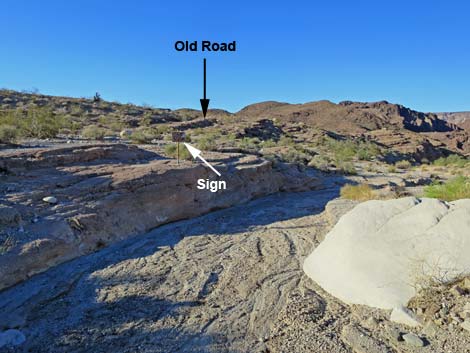 Trail sign and old road in the background (view SW) |
At about 0.5 miles out, hikers can see a trail climbing the left bank (Wpt. 03) and exiting the wash to the southwest. Then, at about 0.6 miles out, adjacent to a "climb to safety" flash-flood warning sign, an old road can be seen exiting the wash to the left. Either of these routes can be used to exit White Rock Wash and hike over to Hot Spring Canyon. Out of the wash, the trail runs up over a low ridge, drops across a wash, climbs over a second low ridge, and drops into the next wash where it merges with the old road. Alternatively, hikers can follow the old road as it contours across the hillsides. Shortly after merging with the old road, the trail leaves the old road and runs up across a hillside onto a ridgeline (Wpt. 20), which is the highpoint along the Washes Route. At this point (Wpt. 20), the Washes Route and Mountains Route diverge. The Mountains Route turns right and heads west into the mountains, while the Washes Route turns left and heads south down into the canyon. |
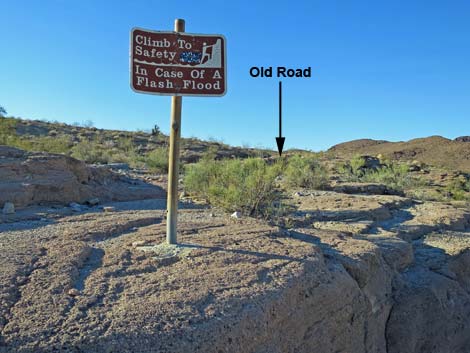 Trail sign and old road in the background (view SW) |
From the highpoint (Wpt. 20), the Washes Route turns left and heads south. The trail runs across slickrock hillsides for 0.27 miles, eventually dropping into a sandy wash (Wpt. 19). The route then follows this wash downhill all the way to the hot spring and the Colorado River beyond. Shortly after dropping into the wash, the wash merges with another wash coming down from the east, and both run into a V-shaped gully between two low ridges (Wpt. 18). The canyon suddenly narrows and drops into a slot that isn't obvious from above. The canyon narrows and deepens, and in about 10 minutes hikers round a corner to the top of a 25-ft pour-over with no apparent way down (Wpt. 17). The route passes this obstacle along the north wall (right on the way down). Climb up about 10 feet to a ledge, then follow the ledge west around the corner past the pour-over. The route then descends the steep, 30-ft-high, 4th-class rock face back into the wash. The climbing is easy, and the handholds are big, but if you fall you die -- so be careful. |
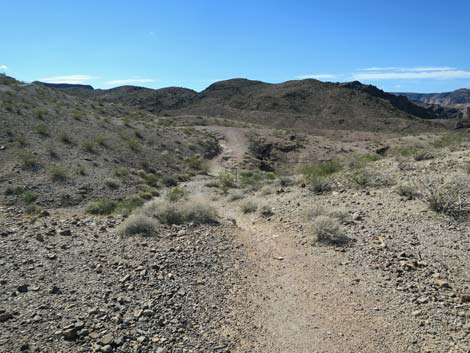 Trail drops into a wash and joins an old road (view SW) |
Below the big pour-over, there are two more pour-overs before getting out of the narrows. The first is about 5 minutes below the big pour-over (Wpt. 16). This one requires about 20-25 ft of 3rd-class scrambling down a smooth slot adjacent to the main pour-over. Fortunately, the top is easy, so hikers are close to the ground before it gets more challenging. The second pour-over is a few minutes farther down. This one requires about 15-20 ft of 3rd-class face climbing on big holds adjacent to the pour-over. From the big pour-over, it takes less than 15 minutes to pass the narrows. Below the narrows (Wpt. 15), the route continues down the canyon for about 15 minutes to a confluence with another major wash (Wpt. 14). Stop for a minute and look around the area so you will remember the way out. Small red and white arrows painted on the rocks will help, but people get confused here. |
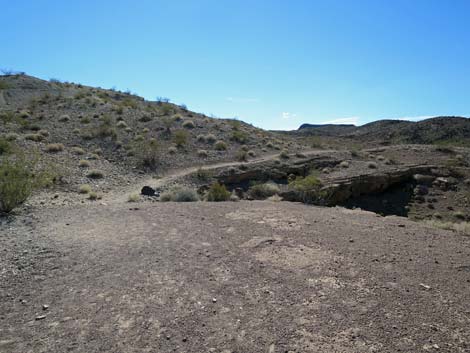 Trail contours across hillside on old road (view SW) |
From the confluence, the route continues down the wash. Watch for the bottom end of the Mountains Route (Wpt. 23) in case you want to go back that way. About 40 minutes below the confluence, the route enters another set of narrows (Wpt. 13), the top of which is marked by a cottonwood tree and a mesquite thicket. The wash drops into a slot (10-ft easy scramble down) where the bottom of the slot has a small pool of hot water. The hot springs and hot pools are just around the corner (Wpt 12). From the hot springs, either return to the trailhead by hiking out the Mountain Route or the Washes Routes, or consider making a big loop and hiking out using the White Rock Canyon route, which requires no serious climbing and is not steep, but it is longer. |
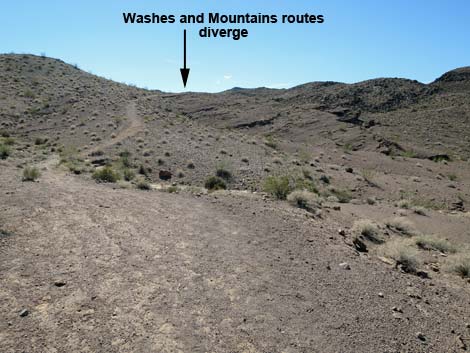 The trail eventually climbs onto a low ridge (view SW) |
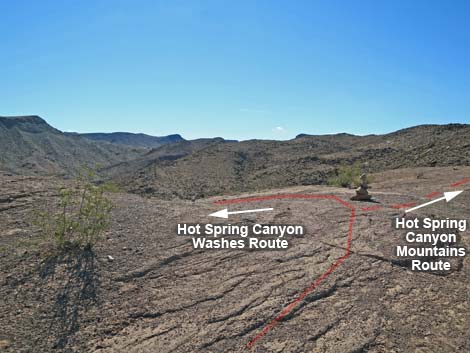 Trail junction: Washes and Mountains routes diverge (view SW) |
 Trail junction: Washes and Mountains routes diverge (view W) |
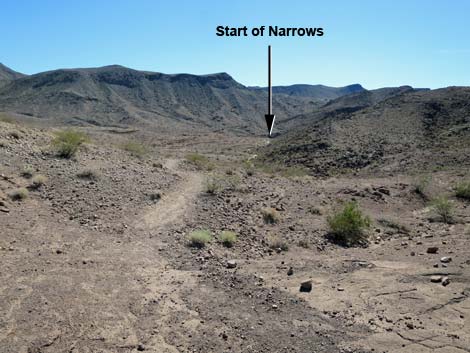 Washes Route descends into Hot Spring Canyon (view S) |
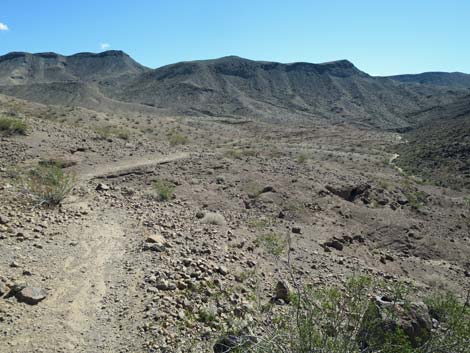 Descending into Hot Spring Canyon (view S) |
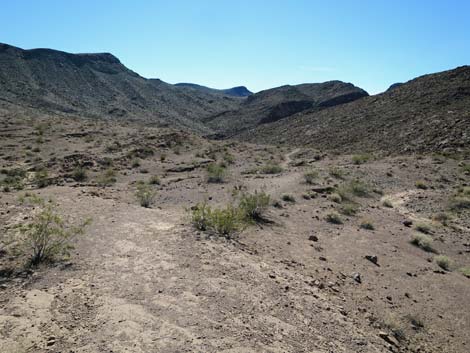 Descending into Hot Spring Canyon (view S) |
 Hot Spring Wash (view S) Hot Spring Wash (view S) |
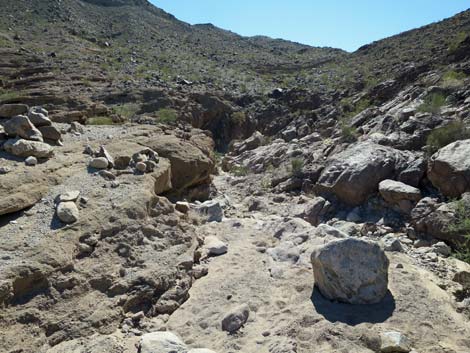 Hot Spring Wash gets narrow, but not deep (view S) |
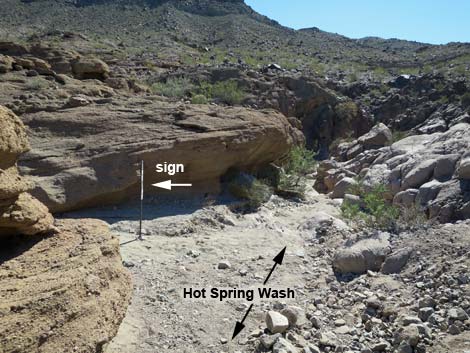 Trail sign along Hot Spring Wash (view S) |
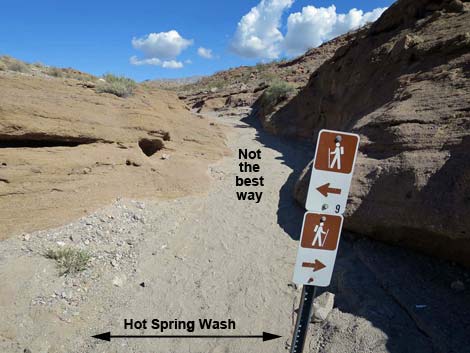 Sign suggesting this is not the best way (view E) |
 Route continues down wash (view S) |
 Wash turns a corner, and ... |
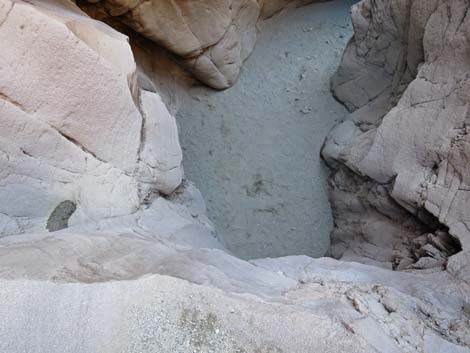 ... oops; perhaps not the best way down |
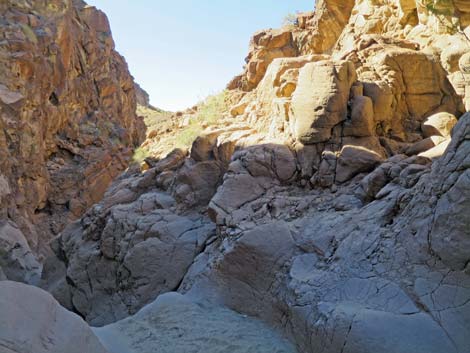 Bypass the pour-over on the right (view SW) |
 Bypass traverses easy ledge system |
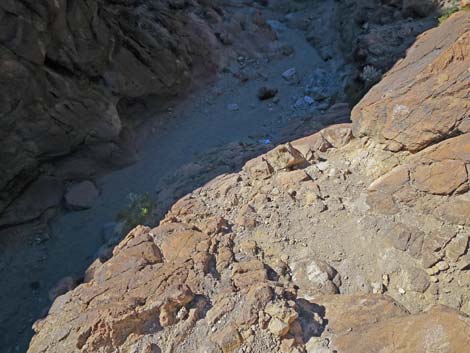 Top of 30-ft, Class-4 downclimb |
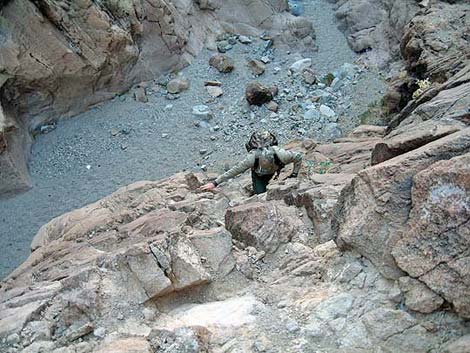 The downclimb is far easier than it looks |
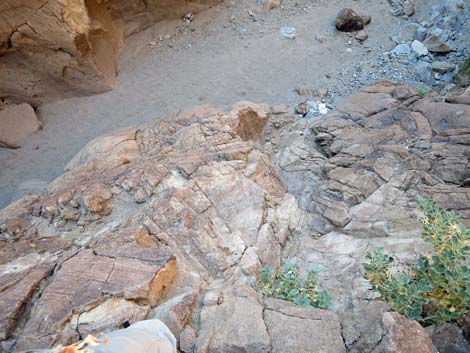 The downclimb is far easier than it looks |
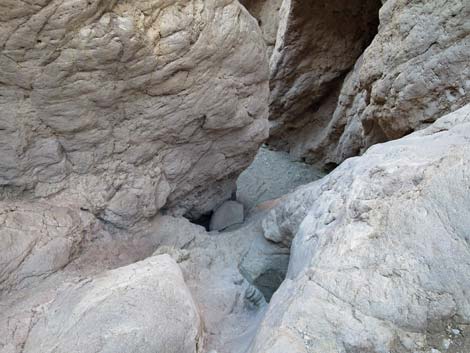 Middle pour-over (3rd-class) |
 Hiker at bottom of middle pour-over (3rd-class) |
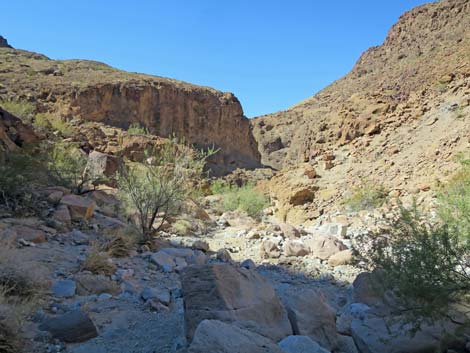 Beyond the pour-overs (view W) |
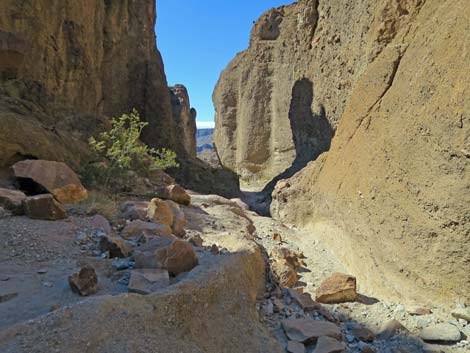 Nice, narrow canyon (view W) |
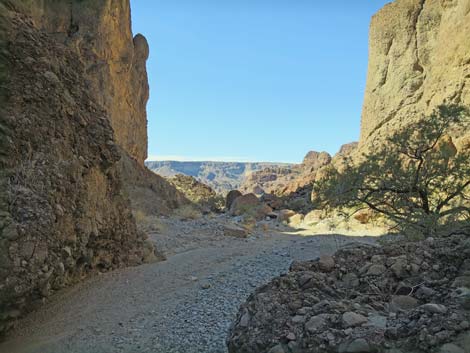 Hot Spring Canyon (view W into Nevada) |
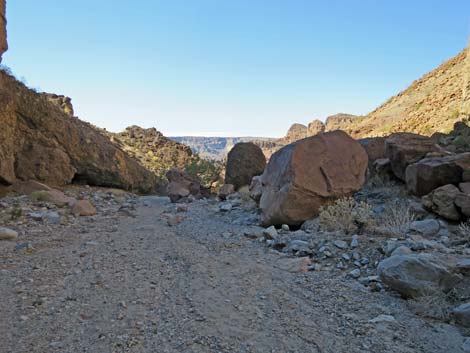 Approaching interesting items on the rocks |
 Interesting items on the rocks |
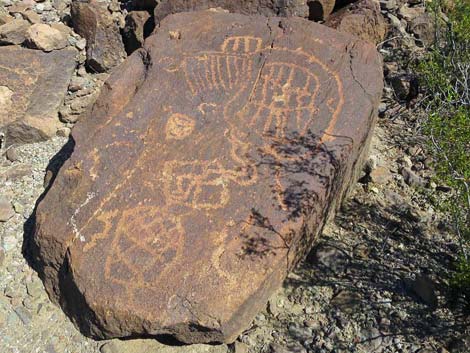 Interesting items on the rocks |
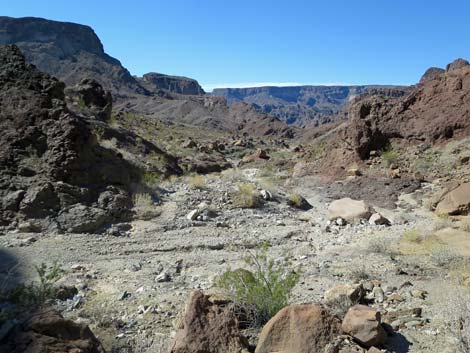 |
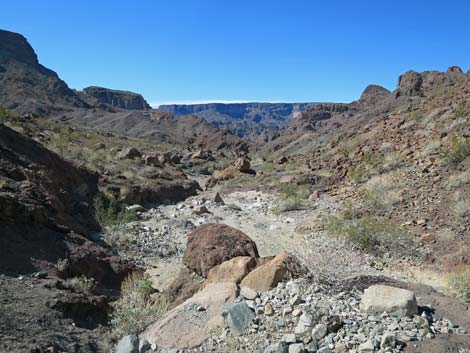 |
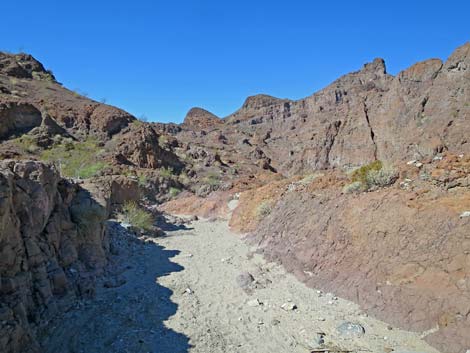 Hot Spring Canyon approaching confluence of major washes (view W) |
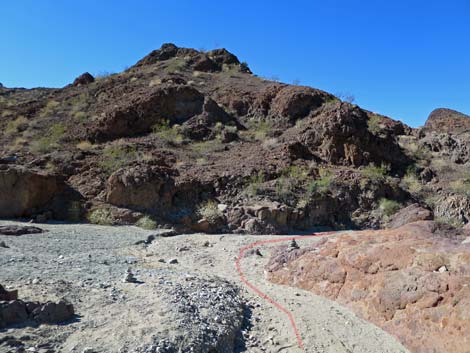 Confluence of major washes; stay right (view W) |
 A small cairn at the confluence; take a look around |
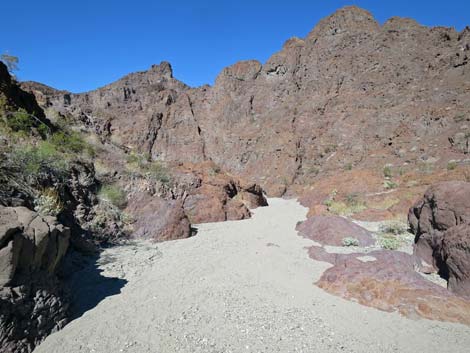 Continuing down Hot Spring Canyon (view NW) |
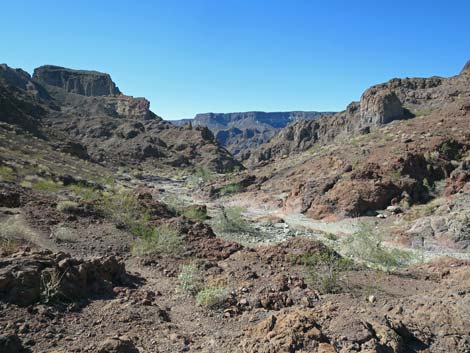 |
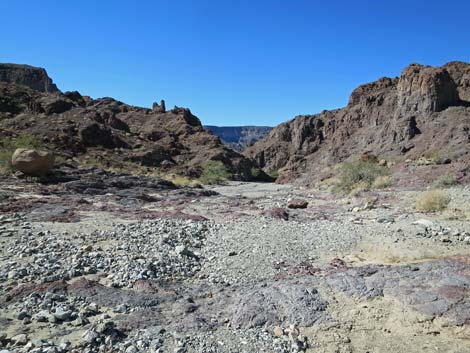 |
 |
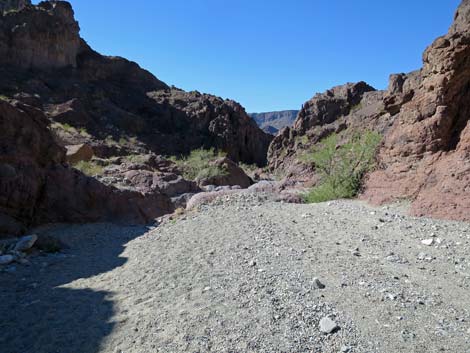 |
 |
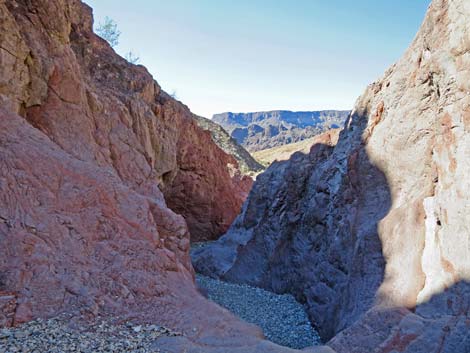 |
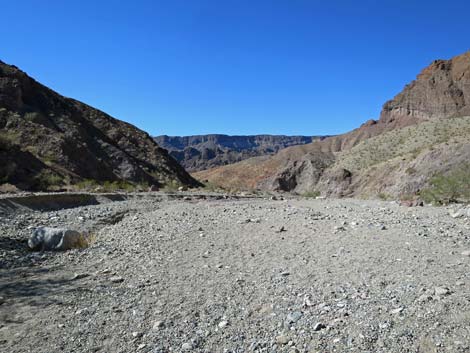 |
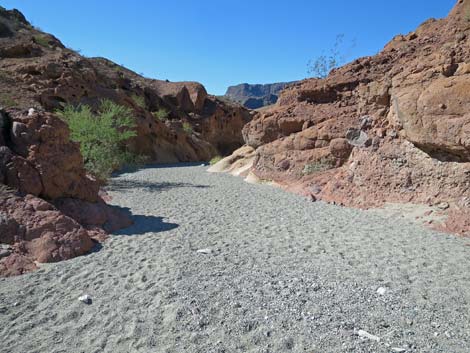 |
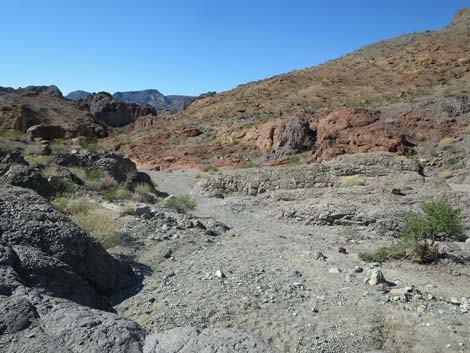 |
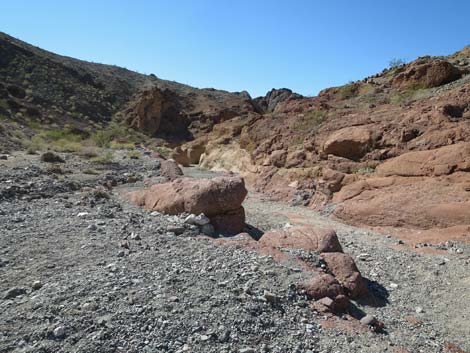 |
 |
 |
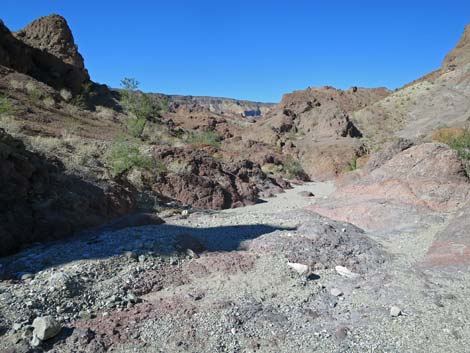 |
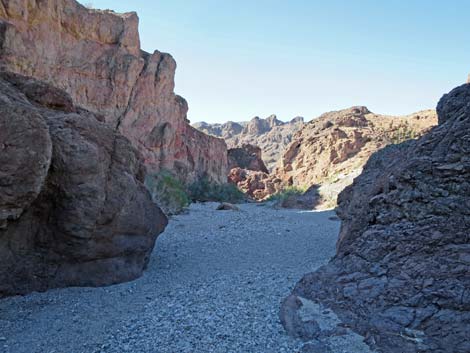 |
 Trash left behind at campsite above the hot springs (view W) |
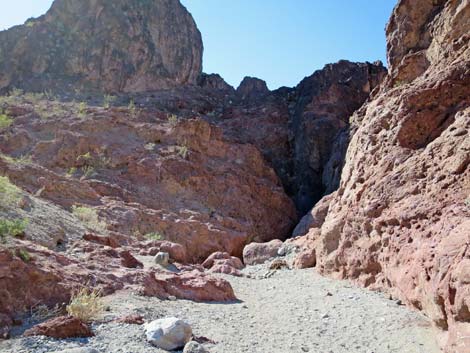 Approaching the hot spring narrows (view W) |
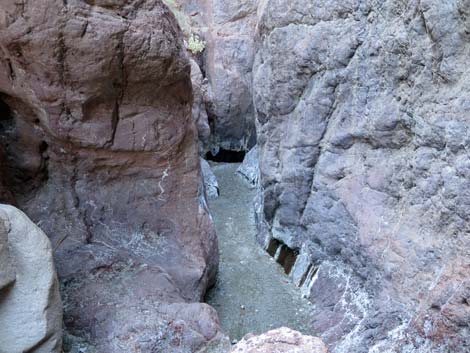 Entering Hot Spring Narrows (view SW) |
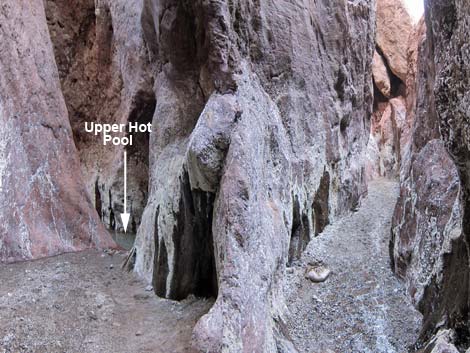 Last bend in the canyon before hot pools (view NE) |
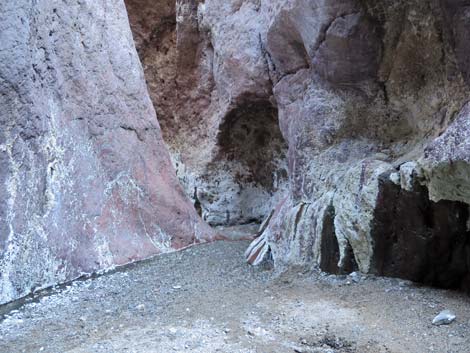 Approaching upper hot pool (view N) |
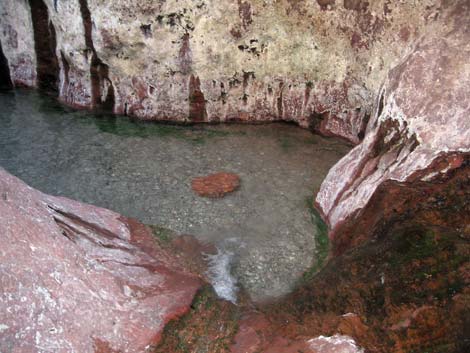 Short slide into Upper hot pool |
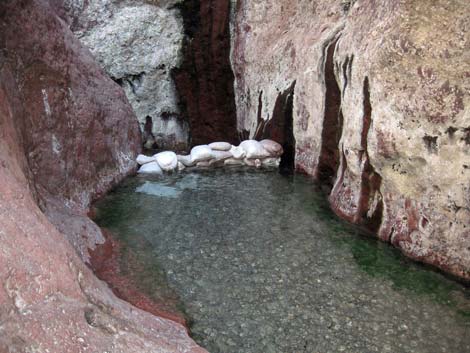 Sandbag dam at far end of upper hot pool |
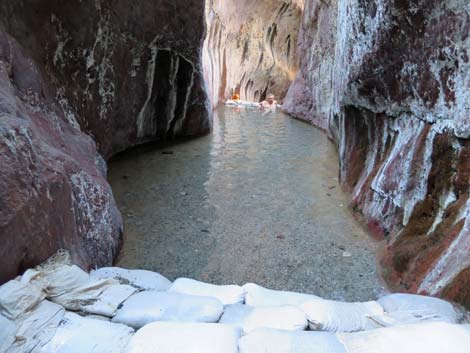 Looking over sandbag dam into next hot pool (view SW) |
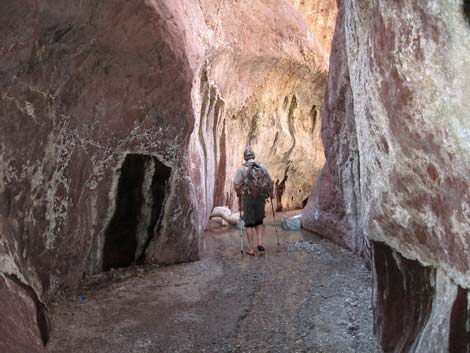 Hiker descending below the upper hot pool |
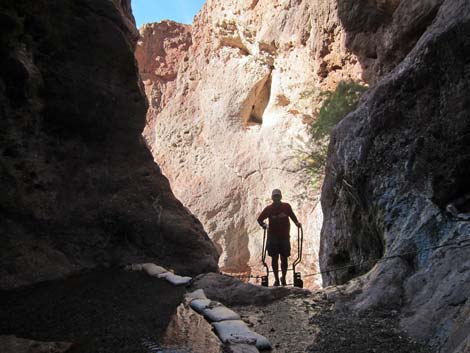 Hiker atop the ladder |
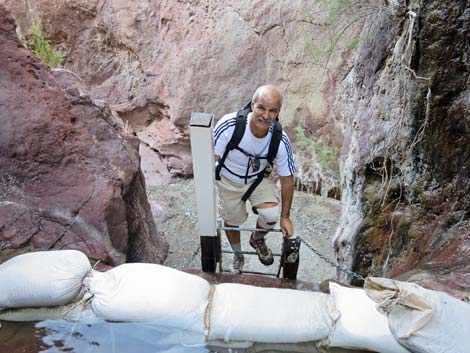 Hiker atop the ladder |
 The ladder is wet, and it is a long way to the bottom! |
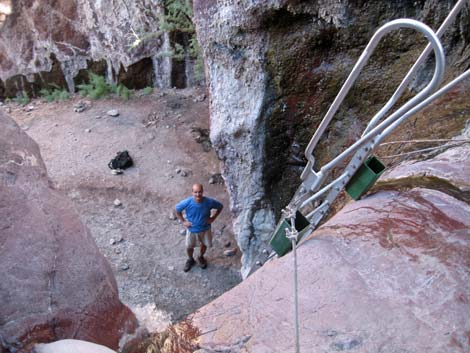 This hiker made it down the ladder |
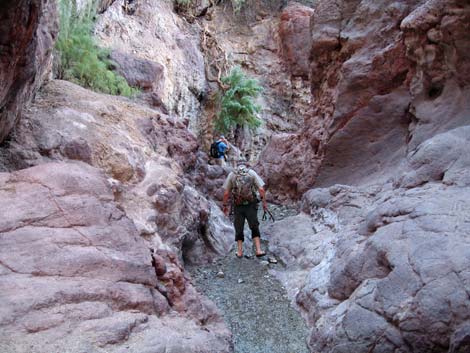 Hikers descending Hot Spring Canyon |
 Hikers descending Hot Spring Canyon |
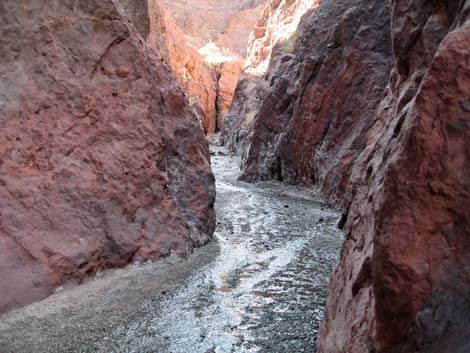 Lower Hot Spring Canyon (view SW) |
 Hot Spring Canyon at junction to White Rock Canyon (view SW) |
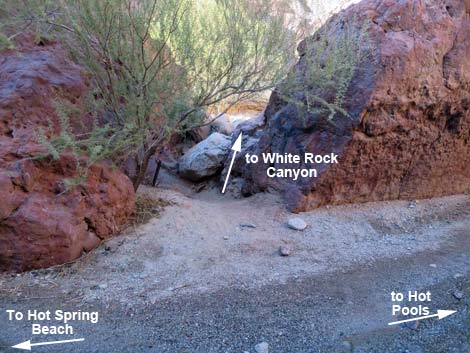 Route to White Rock Canyon (view NW) |
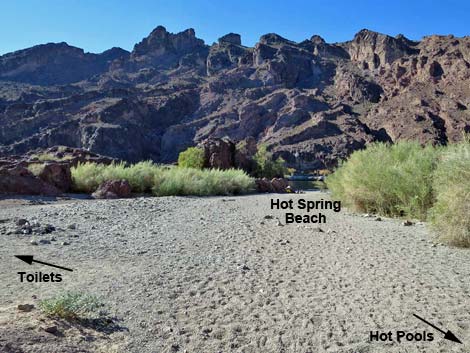 Exiting the canyon onto Hot Spring Beach (view W) |
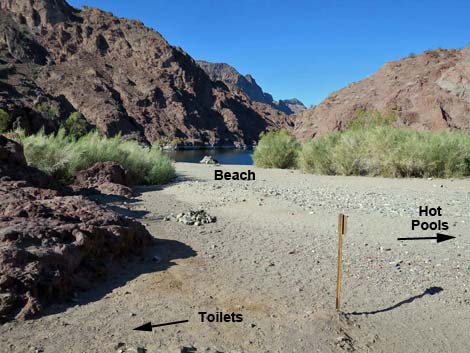 Top of Hot Spring Beach (view NW) |
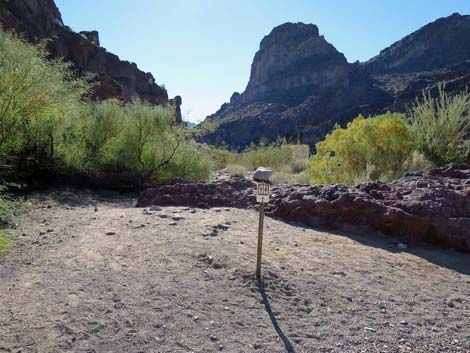 Trail sign for toilets (view S) |
 Short trail to toilets (view S) |
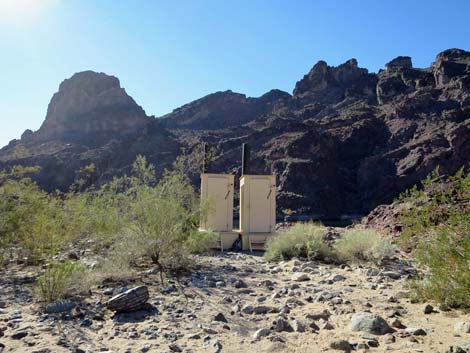 Two vault toilets (view S) |
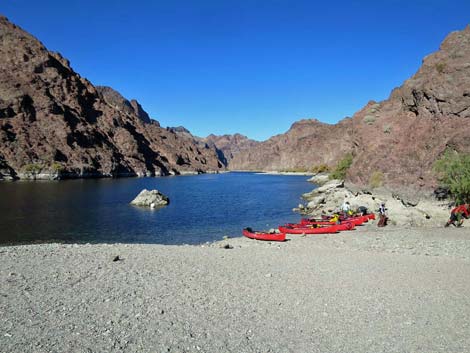 Canoes on Hot Spring Beach (view NW) |
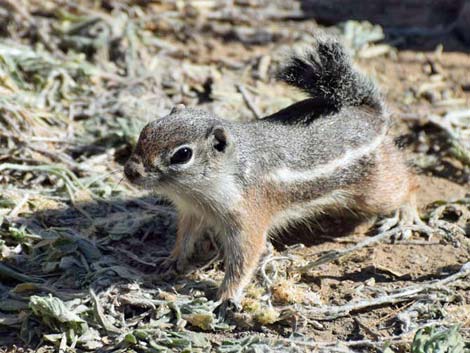 Store food properly: White-tailed Antelope Squirrel |
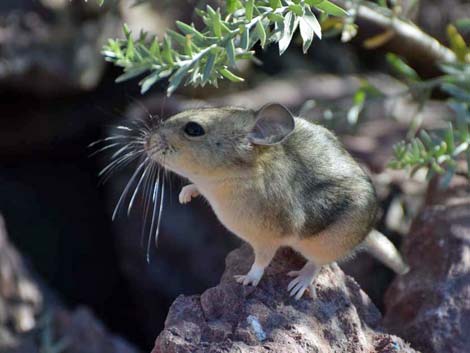 Store food properly: Desert Woodrat |
Table 1. Hiking Coordinates for Washes Route (NAD27; UTM Zone 11S). Download Hiking GPS Waypoints (*.gpx) file.
| Wpt. | Location | UTM Easting | UTM Northing | Elevation (ft) | Point-to-Point Distance (mi) | Cumulative Distance (mi) |
|---|---|---|---|---|---|---|
| 01 | White Rock Canyon Trailhead | 707677 | 3983996 | 1,536 | 0.00 | 0.00 |
| 02 | Trail Signs | 707597 | 3983812 | 1,492 | 0.15 | 0.15 |
| 03 | Hot Spring Canyon Route | 707130 | 3983517 | 1,393 | 0.36 | 0.51 |
| 20 | Crossing Ridge | 706875 | 3983095 | 1,420 | 0.34 | 0.85 |
| 19 | Entering Wash | 706987 | 3982749 | 1,318 | 0.27 | 1.12 |
| 18 | Washes Merge | 707032 | 3982574 | 1,309 | 0.12 | 1.24 |
| 17 | Above Pour-Over | 707023 | 3982526 | 1,290 | 0.04 | 1.28 |
| 16 | 3rd-class Pour-Over | 706990 | 3982517 | 1,251 | 0.05 | 1.33 |
| 15 | Bottom of Narrows | 706758 | 3982472 | 1,189 | 0.18 | 1.51 |
| 14 | Canyons Merge | 706478 | 3982366 | 1,126 | 0.21 | 1.72 |
| 23 | Mts Rt - Washes Rt Jct | 706204 | 3982315 | 1,077 | 0.23 | 1.95 |
| 13 | Above Hot Springs | 705232 | 3981811 | 770 | 0.85 | 2.80 |
| 12 | Arizona Hot Springs | 705211 | 3981772 | 757 | 0.02 | 2.82 |
| 11 | Lower Hot Springs Canyon | 705061 | 3981744 | 653 | 0.18 | 3.00 |
| 24 | Hot Spring Beach | 704941 | 3981656 | 682 | 0.12 | 3.12 |
Happy Hiking! All distances, elevations, and other facts are approximate.
![]() ; Last updated 240708
; Last updated 240708
| Hiking Around Lake Mead | Hiking Around Las Vegas | Glossary | Copyright, Conditions, Disclaimer | Home |